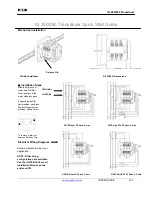
4
4
C
C
H
H
A
A
N
N
N
N
E
E
L
L
A
A
N
N
A
A
L
L
O
O
G
G
U
U
E
E
T
T
R
R
A
A
N
N
S
S
M
M
I
I
T
T
T
T
E
E
R
R
1
1
4
4
O
O
F
F
3
3
0
0
1
1
2
2
0
0
-
-
1
1
8
8
8
8
-
-
1
1
2
2
T
T
Y
Y
P
P
E
E
S
S
I
I
L
L
B
B
U
U
S
S
-
-
T
T
X
X
4
4
A
A
(
(
G
G
)
)
U
U
S
S
E
E
R
R
'
'
S
S
M
M
A
A
N
N
U
U
A
A
L
L
I
I
s
s
s
s
u
u
e
e
:
:
0
0
5
5
OFF channel. An example of an SBMAP is shown below with channels A4, P7 and P8 on
or active:
TX4A::>SBMAP
ABCDEFGHIJKLMNOP
0000000000000000
0000000000000000
0000000000000000
1000000000000000
0000000000000000
0000000000000000
0000000000000001
0000000000000001
TX4A::>_
The SBMAP command is particularly useful when used with the repeat command as this
will display a continuously updated table.
6.7 SILBUS STATUS COMMAND
The SILBUS status command displays the number of SILBUS channels available on the
connected SILBUS network, a SILBUS synchronisation pulse count and a SILBUS error
count. This command is used to determine if the connected SILBUS network is functioning
correctly and how many channels are available. The error count should typically be zero
while the sync count should be incrementing. Once again the use of the repeat command
will provide a dynamic updating display. An example of the SBSTAT command follows:
TX4A::>SBSTAT
No. Chan = 128, Sync Count = 17807, Error Count = 0
TX4A::>_
The error count will be non zero whenever the connected SILBUS network is out of
specification. The error count can be non zero if the connected SILBUS network channel
generator has its power supply cycled off and on. These error counts should be ignored.
6.8 SILBUS GET COMMAND
The SILBUS get command is used to display the status of one selected SILBUS channel
only. If this command is used in conjunction with the repeat command a continuously
updating display can be achieved. The command is invoked by entering the command
name followed by the desired channel address as shown in the two examples below:
TX4A::>SBGET M3
M3 = OFF
TX4A::>SBGET B7
B7 = ON















































